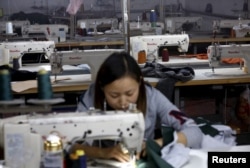Chinese investment in the United States is expected to break records this year, as massive amounts of money continue to flow from China. Chinese companies looking to expand and merge with U.S. firms are expected to invest $20 billion to $30 billion in many sectors.
Sean Miner oversees the China program at the Peterson Institute for International Economics, and said this is good news for the U.S. economy.
“It’s going to bring thousands of direct and indirect jobs," the company says.
Officially as the composition of the Chinese investment in the U.S. changes now, around two-thirds of that investment is in services, from entertainment, health care, IT and financial services. Chinese companies are not just going to merge with these firms, purchase these firms, but also create new investment, improve this process.”
China invested $11.9 billion in the United States in 2014; investment grew to $15 billion last year.
These figures are just a fraction of China’s outbound capital flow, most of which still goes to Europe and Asia. Only one-eighth of China’s outbound investment went to the United States last year. Those figures are set to grow though, as concerns about China’s economic slowdown and the strength of its currency persist.
Currency concerns
Raymond Yeung, China economist at ANZ, said, “There is also worry about weakening of the Chinese yuan, and these expectations for depreciation basically prompt investors to send money abroad in order to chase a higher yield and protect the currency value.”
While Chinese investment in the United States lags behind Japan, Germany and Britain, it faces greater scrutiny.
Many Chinese deals are evaluated by the Committee on Foreign Investment in the United States, an interagency panel that examines foreign acquisitions of U.S. companies. In this election year, the pace of Chinese investment, while reaching record highs, may be hindered by concerns over national security, and complaints that China’s markets are not open to equal amounts of investment by American firms.
A bilateral investment treaty between the United States and China has stalled, and Anbang Insurance Group’s failed acquisition of Starwood Hotels and Resorts may be an example of the kinds of hurdles that Chinese companies face in purchasing U.S. assets. Anbang walked away from the $14 billion deal, following criticism of a lack of transparency over its ownership and financial structure.
Transition
Despite these hurdles, Chinese investment will continue to pour into the United States, driven also by China’s transition from a manufacturing economy to one based on expanding technological and service sectors. This economic shift is pushing Chinese firms to merge with companies in the West that have the brands and technological know-how that China needs.
Shaun Rein, founder of China Market Research Group, said, “They’re looking to diversify their revenue streams. So they are looking at more outbound investment, specifically now into the more developed markets, like the U.S. and western Europe. The second reason why they are going abroad is they are looking to buy technology, brands and management know-how.”
These mergers are set to be a key part of the strategies of many Chinese companies this year. In the first quarter of 2016, China announced 115 outbound deals, up 51 percent from the same period last year, beating all previous annual records.













